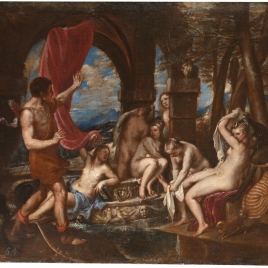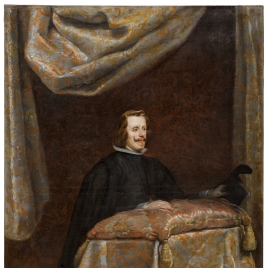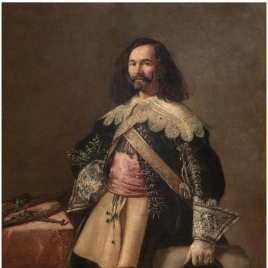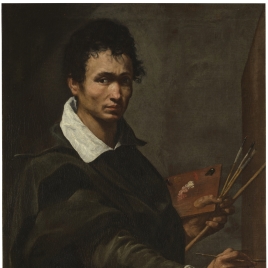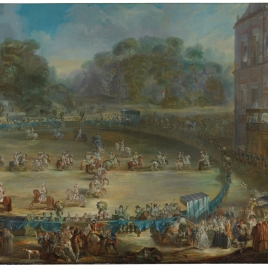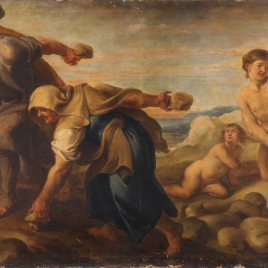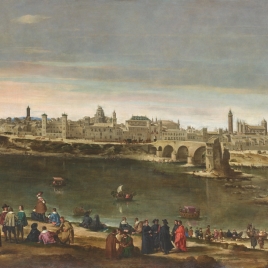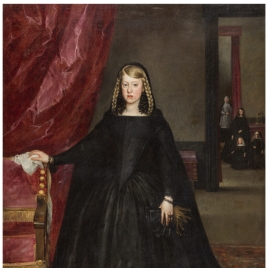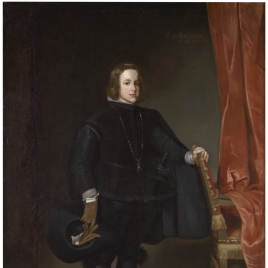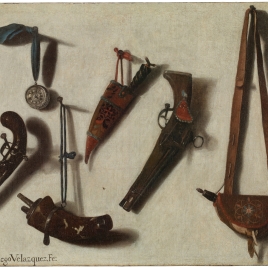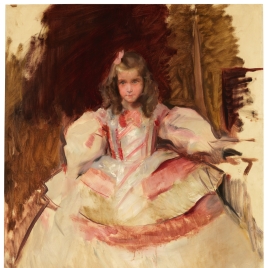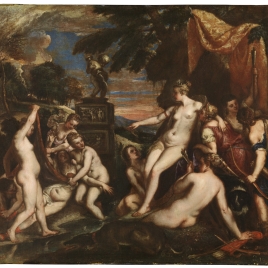Cargando ...
Explore the collection
Artist
Oil on canvas. XVII century
Martínez del Mazo, Juan Bautista (Copy after: Rubens, Peter Paul)
Oil on canvas. Ca. 1663
A. E. Pérez Sánchez publicó en 1970 su fotografía y su identificación en los inventarios antiguos de El Escorial (Madrid 1970a). En la actualidad, el formato de la obra aparece alterado en todos sus lados, principalmente por mutilaciones en la parte baja y el lado izquierdo; hasta su reciente restauración presentaba un aspecto muy desvirtuado. Hasta ese momento no se había apreciado la costura en
Oil on canvas. 1650
Martínez del Mazo, Juan Bautista (Copy after: Titian (Tiziano Vecellio))
Oil on canvas. 1650
Martínez del Mazo, Juan Bautista (Copy after: Titian (Tiziano Vecellio))
After studying the canvas, the pigments, and the technique of this work as well as those of Diana and Callisto (P424), we can be sure that these paintings are 17th-century Spanish copies. The originals of these paintings were some of Titian’s masterpieces from his final years. They belonged to the royal collections starting with the reign of Philip II the Prudent. However, Philip V gifted them to
Oil on canvas. Ca. 1655
Velázquez, Diego Rodríguez de Silva y (Workshop of)
This pair of portraits (P001220 and P001222) combines several aspects of Spanish portraiture of the Baroque period. In principle, the figures of Philip IV and his second wife, Mariana of Austria, are a continuation of the donor-tradition that goes back to medieval religious painting. The client would be incorporated, kneeling or prostrate in a reverential position, into the religious scene that he
Oil on canvas. Ca. 1635
Rizi, Juan Andrés (Attributed to)
This man, standing in the close foreground and occupying almost the entire height of the painting, is a soldier, as the various elements of his dress attest: the broad-brimmed hat, adorned with a feather, which he holds in his left hand; the sash crossing his chest from which hangs a sword; the military cassock; the riding boots with one very visible spur. The richness of detail in the execution o
Oil on canvas. XVII century
Martínez del Mazo, Juan Bautista (Copy after: Rubens, Peter Paul)
Oil on canvas. 1600 - 1610
Borgianni, Orazio (Attributed to)
This work was registered with the number 227 in the 1794 inventory of paintings at the country estate of the Duke of el Arco (a part of the testament of Charles III), where it was identified as a portrait of painter Juan Bautista Martínez del Mazo. The 1920 painting catalog of the Museo del Prado lists it, instead, as a self-portrait by Esteban March but the inclusion in Dibujos españ
Oil on canvas. 1770
This is Paret’s first large-format painting. The painting demonstrates how he had mastered composition in perspective with numerous figures from very early in his career. It also shows that he had already developed his characteristic painting style, affected and tending towards a cold range of chromaticism pearly in appearance. He painted it at the request of his protector, the Infante Don Luis, p
Oil on canvas. XVII century
Martínez del Mazo, Juan Bautista (Copy after: Cossiers, Jan)
Oil on canvas. 1657
Martínez del Mazo, Juan Bautista
Una figura con la poderosísima personalidad artística de Velázquez no podía por menos que dejar una profunda huella entre los demás pintores de la corte española. Esta influencia se notó especialmente en el retrato, pero también se advierte en otros géneros. Uno de ellos es el paisaje, y como ejemplo tenemos esta obra, que durante mucho tiempo estuvo atribuida al propio pintor sevillano. Se trata
The calle de la Reina in Aranjuez
Oil on canvas. XVII century
Martínez del Mazo, Juan Bautista
A la izquierda, el agua del Tajo y en su orilla, grupos descansando. Un guarda abre la puerta del paseo, sombreado por grandes árboles. En 1794, la obra se encontraba en la pieza de comer el príncipe, en el Palacio de Aranjuez.
Oil on canvas. 1647
Martínez del Mazo, Juan Bautista
The view is from the riverbank opposite the city, where several groups of people are spread out, enlivening the composition. In the background one can see Saragossa´s main buildings and Felipe IV entering the city. The work was commissioned by Prince Baltasar Carlos, who indicated the exact viewpoint from which it was to be painted, and the artist used it as an opportunity to recreate a magnificen
Oil on canvas. 1665 - 1666
Martínez del Mazo, Juan Bautista
Margarita was born on 12 July 1651, the daughter of Philip IV and Mariana of Austria. On 12 December 1666, she married Emperor Leopold of Austria and died seven years later in Vienna. The fact that the princess is wearing mourning dress in this painting helps date it between September 1665 -when her father died- and her wedding in December 1666. Those dates suggest that the portrait was made in or
Oil on canvas. Ca. 1655
Velázquez, Diego Rodríguez de Silva y (Workshop of)
Oil on canvas. Ca. 1655
Velázquez, Diego Rodríguez de Silva y (Workshop of)
This pair of portraits (P01220 and P01222) combines several aspects of Spanish portraiture of the Baroque period. In principle, the figures of Philip IV and his second wife, Mariana of Austria, are a continuation of the donor-tradition that goes back to medieval religious painting. The client would be incorporated, kneeling or prostrate in a reverential position, into the religious scene that he o
Oil on canvas. 1645
Martínez del Mazo, Juan Bautista
Baltasar Carlos (1629-1646) was the son of Philip IV and the heir to the throne. He is depicted here shortly before his early death in an image that adheres to the type devised by Velázquez for his early court portraits such as that of the Infante Don Carlos (P1188). As in that work, the sitter here wears a dark suit and holds his glove in a particularly elegant manner.
Oil on canvas. Ca. 1700
Although this painting bears a curious apocryphal signature in large letters at the lower left corner of the canvas, Pérez Sanchez (1983) attributed it to Victoria in 1983 on the basis of its Valencian provenance and that clergyman’s (he was a canon) reputation for making works of this sort. But, while other collections have similar pieces, this attribution raises doubts that may eventually
María de Figueroa, dressed as a menina
Oil on canvas. 1901
Sorolla was the most gifted Spanish painter of his generation, excelling in portraiture. In the early years of the twentieth century, and especially after the encouragement of winning the Grand Prize in the 1900 Exposition Universelle Paris, he demonstrated the influence of Velázquez through the use of long, confident brushstrokes. This portrait of María de Figueroa y Bermejillo -the
Oil on canvas. Ca. 1650
Martínez del Mazo, Juan Bautista (Copy after: Titian (Tiziano Vecellio))
Oil on canvas. Ca. 1650
Martínez del Mazo, Juan Bautista (Copy after: Titian (Tiziano Vecellio))
After studying the canvas, the pigments, and the technique of this work as well as Diana and Callisto (P00424), we can be sure that they are Spanish copies from the 17th century. The originals of these paintings, some of the masterpieces by Titian in his final years, belonged to the royal collections from the time of Philip II the Prudent. However, Philip V gifted them to the Marquess of Gramont i
Loading...



